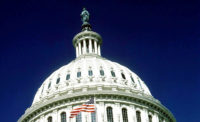OSHA’s final rule on Occupational Exposure to Respirable Crystalline may not be so final after all.
During a hearing yesterday by the Subcommittee on Workforce Protections entitled, “Reviewing Recent Changes to OSHA’s Silica Standards,” its chairman, Republican Congressman Tim Wahlberg (MI-07), hinted that Congress may attempt a legislative end run around the regulation.
Wahlberg criticized OSHA for “crafting an entirely new regulatory regime” to control workers’ exposure to silica, rather than using the tools at its disposal to enforce existing standards. The previous permissible exposure limits (PELs) for crystalline silica were adopted in 1971 and have not been updated since that time.
Where exposure occurs
About 2.3 million workers in the U.S. face exposure to respirable crystalline silica, a substance which can cause silicosis, a debilitating and often fatal lung disease. Exposure is common in the construction industry when materials containing silica – such as concrete and stone -- are drilled and cut, and in operations such as brick manufacturing, foundries and hydraulic fracturing.
OSHA estimates that the final rule, which lowers the permissible exposure limit for crystalline silica to 50 micrograms per cubic meter of air averaged over an eight-hour shift, will save more than 700 lives annually and prevent more than 1600 new cases of silicosis each year.
Wahlberg said concerns have been raised about whether the new standards can be responsibly enforced. “It has been suggested that silica cannot be accurately measured at the reduced limit prescribed in the new rule, because many labs don’t have the technology necessary to provide reliable results. Will employers—acting in good faith and trying to do the right thing—be held accountable for an enforcement regime that isn’t feasible or practical?
New controls may be "unworkable"
“Can these new rules be effectively implemented on the ground and under the timeframe prescribed by OSHA? Employers may lack the time and resources necessary to adjust their workplaces to the requirements of the new rule. Others may find new controls simply unworkable.”
Wahlberg cited data from the National Federation of Independent Business showing that the rule will cost workplaces more than $7 billion each year, which he said would result in higher costs for consumers and fewer jobs for American workers.
A "fundamental lack of understanding"
Ed Brady, a second-generation home builder from Illinois, said. “OSHA’s final silica rule demonstrates a fundamental lack of understanding for how the construction industry—and in particular residential construction—operates.”
Brady said OSHA developed a rule designed for workers who perform the same tasks on the same sites every day,” he said. “That is not the pattern on jobsites where workers perform many and varied tasks in a variety of different environments.”
Coming in two billion dollars below Wahlberg’s figure, Brady said the Construction Industry Safety Coalition (CISC) estimated that the total costs of the rule would be cost industry nearly five billion dollars annually – well above OSHA’s estimate of one billion dollars.
Congress should prevent rule from taking effect
He urged Congress to “take the lead and move swiftly to craft legislation that will keep this fundamentally flawed rule from taking effect.”
Janis Herschkowitz, who owns a small, second-generation metalcasting company in Pennsylvania, predicted that foundries will have to exhaust all feasible engineering and work practice controls to meet the new limits.
“Some foundries may spend millions of dollars retrofitting and… rebuilding in order to implement the various types of engineering controls—essentially trial and error—while attempting to comply with the new standard.”
The subcommittee also heard from Dr. James Melius, M.D., Dr.P.H., an occupational health physician and epidemiologist who focuses mainly on construction safety and health issues.
“I believe that OSHA has done an excellent job in developing the new silica standard including their review of the available scientific information on silica and in crafting regulations that will provide better protection for workers exposed to this dangerous material,” said Dr. Melius, who said the final rule will significantly reduce the incidence of silicosis and other silica-related diseases in the U.S.
New rule provides a comprehensive approach
He added that the new silica standard is a significant improvement because it is comprehensive “The previous OSHA silica standard was essentially just a number – levels of exposure needed to be controlled to a specific level as measured over an 8 hour work day. There were no other requirements or guidance directly attached to the standard such as training, exposure monitoring, medical surveillance, and specific control requirements that would help to better protect the exposed workers and also assist the employer in complying with the standard.” The new standard provides guidelines for an approach to controlling silica exposures including monitoring, medical surveillance, training, and other requirements.”
Melius pointed out that the standard also includes the option for construction industry employers to comply with the new standard by employing specific control measures when conducting certain construction tasks rather than having to regularly monitor exposures from that work and adjust their controls based on this monitoring. “This is a major assistance to the construction industry in controlling silica exposures for their workers and for complying with the new standard.”
A press release distributed by the press office of the Education and the Workforce Committee contained quotes from Wahlberg, Brady and Herschkowitz but omitted any mention of Dr. Melius’ testimony.
Issues "have been decided"
The hearing drew the ire of the National Council for Occupatioinal Safety and Health (National COSH).
The group’s Jessica Martinez said the new silica rule has a clear purpose: to save lives, reduce disease and make workplaces safer.
"It's unclear, however, what the purpose of today's hearing is. The concerns employers have about the new rule have been heard and these issues have been decided during an exhaustive regulatory process. OSHA rigorously followed all required rules and procedures and received extensive input from all stakeholders, including workers, employers and safety experts.
"The Subcommittee on Workforce Protections can make better use of its time -- and taxpayer money -- by examining the many other areas in which workers need new, enforceable protections against hazards which claim tens of thousand of lives and cause millions of injuries every year."




